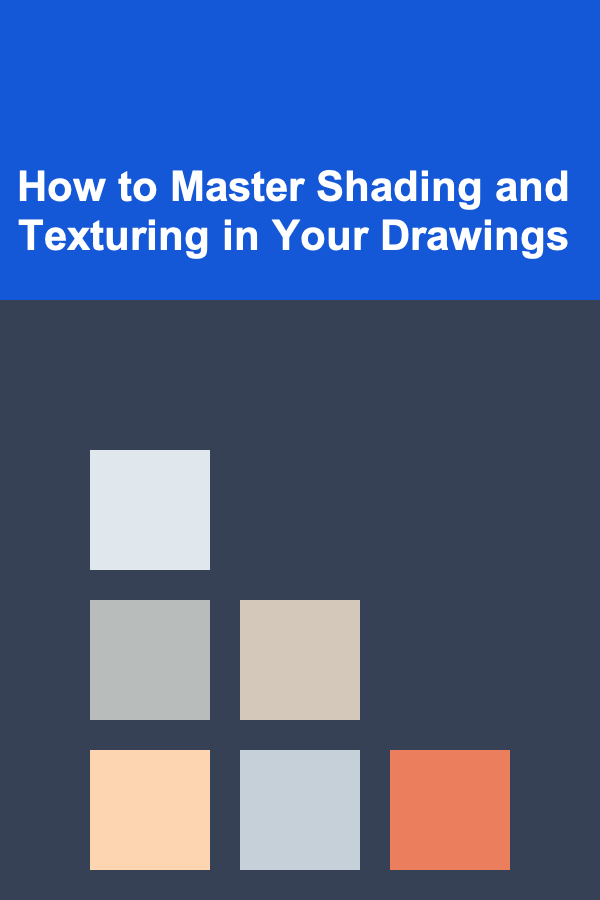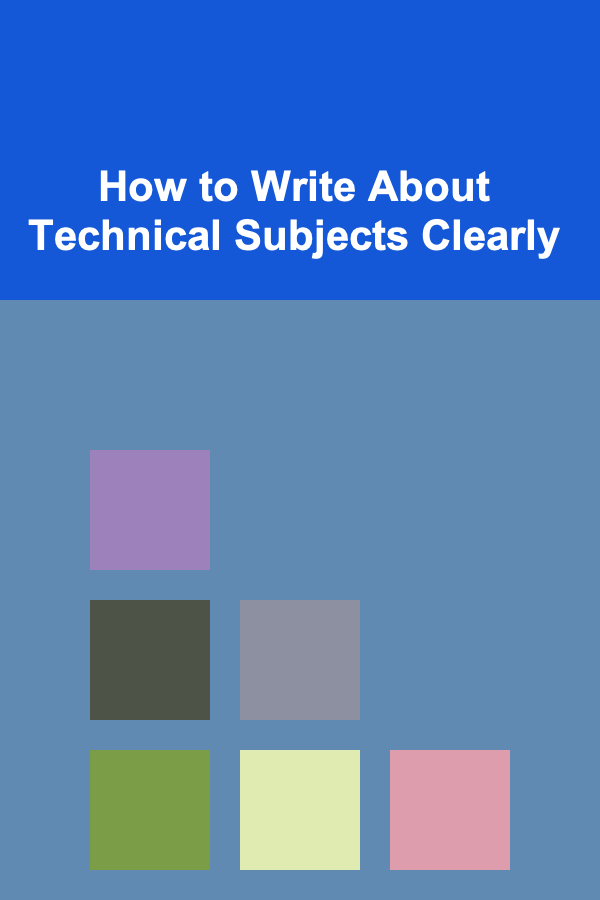
How to Master Shading and Texturing in Your Drawings
ebook include PDF & Audio bundle (Micro Guide)
$12.99$6.99
Limited Time Offer! Order within the next:

Shading and texturing are essential skills for any artist. Whether you're a beginner or an experienced practitioner, mastering these techniques can elevate your artwork, creating depth, volume, and realism. The difference between a flat, lifeless drawing and a dynamic, captivating one often lies in how effectively you apply shading and texture. In this article, we'll explore the fundamentals of shading and texturing, breaking down the techniques and providing insights to help you master them.
Understanding the Basics of Shading
Shading refers to the use of different values (the lightness or darkness of a tone) to represent the light and shadow areas of your drawing. It helps give the drawing depth, form, and realism. Without shading, drawings can look flat and lack dimensionality. Shading can be applied in various ways depending on the medium (pencil, charcoal, digital tools, etc.), but the underlying principles remain the same.
1. Light Source and Its Importance
Before you start shading, it's crucial to identify where your light source is. The position of the light affects how shadows and highlights appear on the object. The light source determines:
- Where the light hits: The areas that face the light will be highlighted.
- Where the shadows fall: The areas opposite to the light source will have shadows or darker tones.
- Cast shadows: Shadows cast on the ground or other surfaces due to the object blocking the light.
When you understand the light source, you can then begin to shade the object in a way that mimics the real world. A light source can be strong and direct or soft and diffused, which will change the appearance of the shading. Understanding this concept is fundamental to realistic shading.
2. Basic Shading Techniques
There are several techniques for applying shading to your drawings, each offering different effects. Let's look at the most common methods:
A. Hatching
Hatching is a technique where parallel lines are drawn to indicate shading. The closer the lines are to each other, the darker the shaded area appears. It's a quick way to add texture and depth to your drawings.
- Cross-hatching: This is a variation of hatching, where two sets of parallel lines are drawn in intersecting directions. This method creates even darker shading areas, enhancing the effect of shadow.
B. Stippling
Stippling involves creating shading using small dots or points. The density of the dots dictates how dark or light the area appears. Stippling can be time-consuming but is great for achieving a smooth transition between light and dark areas.
C. Blending
Blending involves smoothing out the pencil marks to create soft transitions between light and dark areas. This is commonly done with tools such as blending stumps, tissue paper, or even your finger (although this can lead to smudging). Blending is especially useful for creating smooth gradients, like skin tones or smooth surfaces.
D. Scumbling
Scumbling is a technique where you create a textured effect by using small, circular or spiral strokes. It's particularly useful for areas where you want to achieve a soft, uneven texture, such as rough surfaces or fabric.
E. Smudging
Smudging involves using a smudge tool or your finger to soften the edges of the shaded areas. It can be used to create gradients or to blend different shading techniques together.
3. Light and Shadow: The Key to Realism
One of the keys to effective shading is understanding the relationship between light and shadow. In realistic drawings, light and shadow work together to define the volume and structure of the object. To create a convincing three-dimensional look, focus on the following areas:
- Highlights: These are the brightest areas of your drawing, where light hits the object directly. Keep these areas free of shading to preserve the effect of light.
- Midtones: These are the areas where the light gradually transitions into shadow. Shading in midtones should be subtle and gradual.
- Core shadows: These are the darkest parts of the shadow, typically found in areas that are most distant from the light source.
- Reflected light: Sometimes, light bounces off surfaces, creating a subtle illumination in the shadow areas. This effect can add realism to your work.
Understanding how to transition between light and dark values smoothly is crucial for producing a lifelike drawing.
Mastering Texturing in Your Drawings
While shading provides depth and form, texturing adds additional detail and interest to your artwork. Texturing can make a surface appear rough, smooth, bumpy, or shiny. It adds complexity to your drawing and gives it a tactile quality. Just like with shading, texture depends on how the light interacts with a surface and the way your lines or marks are placed.
1. Types of Textures
There are many types of textures you might encounter in your artwork. Here are some of the most common:
A. Smooth
Smooth textures are often associated with shiny surfaces, like glass, metal, or polished wood. To create a smooth texture, use soft, even shading with few visible marks. Blending is essential here, as it helps create the illusion of a sleek, polished surface.
B. Rough
Rough textures, such as stone, brick, or rough fabric, are created with irregular, jagged lines or marks. These marks should vary in length and spacing to mimic the unevenness of a rough surface.
C. Soft
Soft textures can be found in surfaces like skin, fabric, or clouds. To create this effect, use smooth shading with delicate strokes and blend well. For skin, for example, a smooth gradient can suggest softness, while a fabric texture might require a little more directional stroke work to mimic folds and wrinkles.
D. Bumpy
To represent bumpy textures, such as an orange peel or a rock surface, use short, irregular strokes that create a visual impression of bumps. The shadows and highlights between the bumps will help emphasize their roundness.
E. Organic
Organic textures are usually found in natural surfaces like leaves, wood, or animals' fur. These can be drawn with a combination of fine lines, stippling, and hatching. To create the look of fur, for example, long, curved strokes can simulate individual hairs, while shading beneath them will give the fur depth.
2. Techniques for Creating Texture
Just like shading, texturing requires a solid understanding of your tools and techniques. Here are some methods you can use to master texture creation:
A. Directional Strokes
Directional strokes are lines that follow the natural direction of the surface you are trying to render. For instance, when drawing hair or fur, the strokes should follow the natural flow of the strands. For tree bark, your strokes might follow the grain of the wood. This helps create a sense of direction and continuity in your texture.
B. Layering
Layering is the technique of building up your texture slowly. Start with light marks and gradually increase the density of the texture by adding more layers of lines, dots, or strokes. This method helps achieve more depth and dimension, especially when creating rough or organic textures.
C. Contrast
Creating contrast within a texture can help to make it stand out. For instance, for rough stone, make the dark crevices very dark and the raised areas lighter. This will give the impression of depth and detail.
D. Using Reference Images
If you're drawing a specific texture or object, reference images can be invaluable. Observing how light interacts with different textures can inform your technique. Pay attention to the subtleties of texture---how it changes depending on the angle of the light, how it catches highlights, and how shadows deepen in textured areas.
Combining Shading and Texturing
The real challenge in drawing lies in combining shading and texturing effectively. When used together, they can transform a simple outline into a rich, dynamic drawing. To combine shading and texturing:
- Start with the shape and form: Begin by establishing the basic form of your object with light sketching. Then, start adding shading based on the light source.
- Add texture where appropriate: Once the basic shading is done, begin layering in texture. Texture should be applied where it makes sense for the surface of the object.
- Maintain consistency in light and shadow: As you apply texture, remember that the light source should always inform your shading. Textures should follow the same logic as shading in terms of light and shadow placement.
- Refine the details: Finally, go back to refine the texture and shading. Add highlights where necessary, deepen shadows to create more contrast, and smooth out any transitions between light and dark areas.
Practice Tips for Mastery
Mastering shading and texturing takes time and practice. Here are a few tips to help you improve:
- Draw from life: Observing real objects allows you to see how light interacts with different surfaces and gives you a deeper understanding of texture and shading.
- Use different mediums: Experimenting with various tools, such as charcoal, graphite, ink, or digital tools, will give you a broader range of techniques to explore.
- Start simple: Begin with simple objects, like spheres and cubes, to practice basic shading and texturing. As you get more comfortable, move on to more complex subjects.
- Study other artists: Analyze how other artists approach shading and texturing. Studying masterworks can give you insight into techniques and styles you may want to incorporate into your own work.
Conclusion
Mastering shading and texturing is essential for creating realistic, dynamic, and visually compelling drawings. By understanding the relationship between light and shadow, practicing various shading techniques, and learning how to apply textures effectively, you can take your drawing skills to the next level. With consistent practice and a keen eye for detail, you'll soon see a noticeable improvement in your ability to render objects in a three-dimensional space. Remember, art is a journey, so enjoy the process of learning and creating!

How to Organize Your Desk for Maximum Productivity
Read More
How to Organize Your Office Supplies for a Tidier Workspace
Read More
How to Set Up a Checklist for Holiday Decor Cleanup
Read More
Mitigating Human-Wildlife Conflict: A Comprehensive Guide
Read More
Mastering Creative Problem-Solving in Your Career
Read More
How to Write About Technical Subjects Clearly
Read MoreOther Products

How to Organize Your Desk for Maximum Productivity
Read More
How to Organize Your Office Supplies for a Tidier Workspace
Read More
How to Set Up a Checklist for Holiday Decor Cleanup
Read More
Mitigating Human-Wildlife Conflict: A Comprehensive Guide
Read More
Mastering Creative Problem-Solving in Your Career
Read More